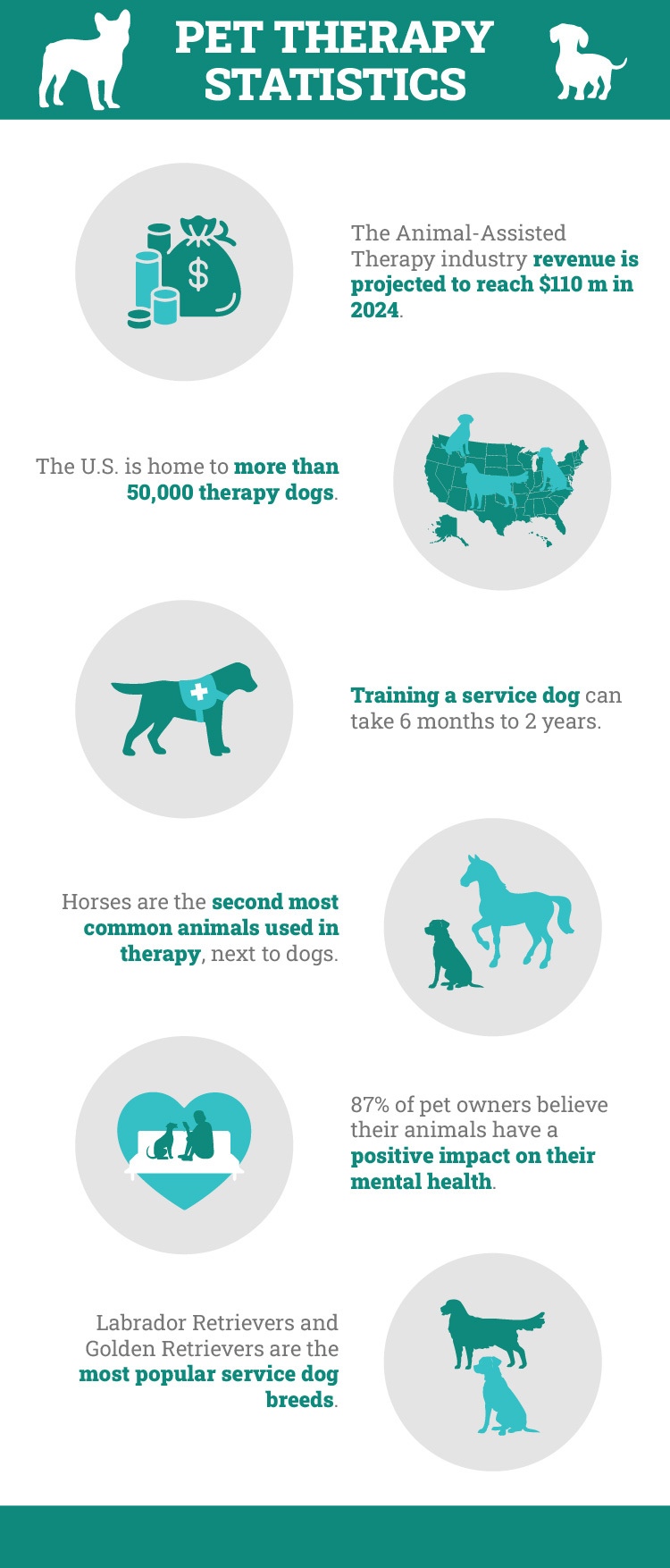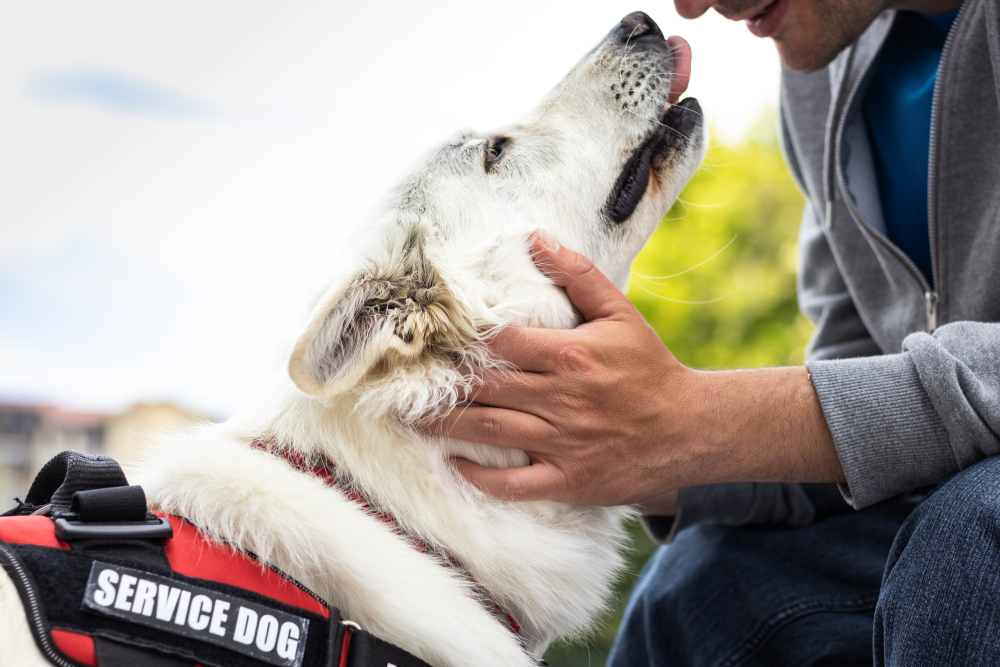In this article
Note: This article’s statistics come from third-party sources and do not represent the opinions of this website.
We all love a good snuggle with our furry companions, especially at the end of our hardest days. Pets have a way of bringing us back to earth, slowing us down, and shifting our focus back to the present moment.
As the scientific data mounts, animal therapy continues to gain recognition for the incredible health benefits animals can bring to us. From reducing stress to improving mental health, studies continue to highlight how our fluffy friends create positive impacts on our bodies and minds as we navigate life together.
Here, we will explore 16 fascinating animal therapy statistics and facts and take a deep dive into the incredible and complex relationships between humans and animals, including how current data suggests that when we give our best to animals, they benefit our well-being in more ways than you can throw a stick at.

Animal Therapy Statistics & Facts
- The Animal-Assisted Therapy industry revenue is projected to reach $110 m in 2024.
- As of 2023, there are nearly 3,700 people in the US employed in the Animal-Assisted Therapy Industry.
- Over 57% of hospices in the US that offer alternative therapies offer pet therapy.
- The U.S. is home to more than 50,000 therapy dogs.
- In a 2020 study, 98% of people with a service dog reported receiving psychosocial benefits from their service dog.
- Training a service dog can take 6 months to 2 years.
- There are now 8 recognized types of service dogs in the U.S.
- Horses are the second most common animals used in therapy, next to dogs.
- A study with animals in the classroom reported significant increases in social behaviors of children with Autism, with over 50% demonstrating an increased interest in attending school during the program.
- 87% of pet owners believe their animals have a positive impact on their mental health.
- Animal therapy reduces the need for pain medication post-surgery by 28%.
- 69% of pet parents report that their pets reduce their stress and anxiety.
- Animal therapy elevates brain activity in patients with a minimally conscious state.
- Animal therapy helps reduce depression by 50% through dolphin-assisted sessions.
- The world’s first therapy dog was a Yorkshire Terrier named Smoky in WWII.
- Labrador Retrievers and Golden Retrievers are the most popular service dog breeds.


General Pet Therapy Statistics
1. The Animal-Assisted Therapy industry revenue in the U.S. is projected to reach $110 m in 2024.
(IBIS World)
This steadily growing industry from 2013 took quite a fall during the COVID-19 pandemic in 2020 when in-person therapy sessions and direct human-animal interactions were limited. The industry, however, is again on an upward trend and is projected to continue growing over the next five years.

2. As of 2023, there are nearly 3,700 people in the US employed in the Animal-Assisted Therapy Industry.
(IBIS World)
The number of people working in the Animal-Assisted Therapy industry has been steadily growing after a hiccup during 2020’s COVID-19 outbreak. The industry had to adapt and has shown resilience, increasing employment in the US by an average of 1.4% between the years 2018 and 2023. This is over 400 businesses nationwide.
3. Over 57% of hospices in the US that offer alternative therapies offer pet therapy.
(CDC)
A study in 2011 reported that 41.8% of hospices in the United States were providing patients with alternative therapies. Of those hospices, 57% were offering pet therapy as support for their end-of-life care. There aren’t any more recent studies reported, but we do know that pet therapy is becoming more popular in every field, so it is safe to assume that pet therapy has increased in hospices over the past decade and a bit, too.

4. The US is home to more than 50,000 therapy dogs
(CDC)
With therapy dogs serving in various environments from hospitals to schools, the US has over 50,000 of these specialized animals providing comfort and emotional support. Therapy dogs are trained to interact with people to help alleviate anxiety, loneliness, and stress.
Source
(PubMed Central)
The study compared expectations and experiences of service dog ownership and highlighted the positive and negative aspects of owning one. When asked about the most helpful aspect of having a service dog, 89% of people who were on the waitlist and were yet to receive their service dog anticipated that most benefits would be physical, and only 74% thought the benefits would be psychosocial. This is in contrast to 70% of those already living with a service dog reporting that the benefits were physical, and 98% living with a service dog reporting that they experienced psychosocial benefits.

6. Training a service dog can take 6 months to 2 years.
(Service Dog Certifications)
Training a service dog is a time-intensive process, generally taking from six months to two years for them to master the skills required for specific types of assistance. This rigorous training ensures these dogs can respond to complex needs, supporting people with mobility challenges, mental health conditions, or medical alerts.
Source

Types of Animal Therapy and Their Unique Benefits
Animals used in therapy are as diverse as the needs they address. Animal-assisted therapy is proving especially beneficial for children and those with unique mental health needs. From helping children with dyslexia improve reading confidence to providing emotional support for children with PTSD, animals offer comfort and aid in therapeutic settings. The calming presence of therapy animals has been shown to improve social skills, reduce anxiety, and foster emotional stability in various populations.
7. There are now 8 recognized types of service dogs in the US.
(Pet MD)
Service dogs are trained to assist with a range of needs, from mobility support to detecting health conditions like low blood sugar. This variety allows people with specific needs to receive tailored support, enhancing their independence and quality of life.
Source

8. Horses are the second most common animals used in therapy, next to dogs.
(Psychology Today)
Equine-assisted therapy, which uses horses to support mental health, is widely recognized as beneficial, particularly in treating PTSD, anxiety, and emotional disorders. The unique bond formed with horses provides emotional healing and fosters trust.
Source
9. A study with animals in the classroom reported that over 50% of participating children with Autism demonstrated an increased interest in attending school during the program.
(PubMed)
The study on animal exposure in the classroom and its effects on social behaviors in children with Autism Spectrum Disorder reported significant improvements in social functioning, social approach behaviors, and social skills, as well as decreases in social withdrawal behaviors.

Emotional and Mental Health Benefits of Pets
The bond between humans and animals goes beyond companionship; pets provide profound emotional and mental health benefits. Research shows that pets can reduce stress, lower blood pressure, and offer comfort during difficult times, with most pet owners reporting a positive impact on their mental health. Whether aiding in recovery from physical surgery or enhancing emotional well-being, pets serve as powerful sources of support and relaxation.
10. 87% of pet owners believe their animals positively impact their mental health.
(American Psychiatric Association)
According to research by the American Psychiatric Association, 87% of pet owners report that their pets improve their mental well-being, offering companionship, comfort, and emotional support during difficult times. Pets reduce feelings of loneliness, alleviate stress, and provide a sense of purpose for their owners.
Source

11. Animal therapy reduces the need for pain medication post-surgery by 28%.
(Science News)
A study by Loyola University Health System indicated that animal-assisted therapy can significantly decrease the need for pain medication following joint replacement surgeries. The need for oral pain medication was 28% less in the animal-assisted therapy group. The comforting presence of therapy animals appears to alleviate pain naturally, improving recovery experiences for patients.
Source
12. 69% of pet parents report that their pets reduce their stress and anxiety.
(American Psychiatric Organization)
In the same survey where 87% of pet owners reported that their pets impacted their mental health, 69% of said owners reported that their pets helped to reduce their stress and anxiety. When these owners were asked about the worries they have regarding their pets, they were most worried about them aging or passing away. So, while pets help with anxiety, they can also be the cause of it but are seemingly worth all the worry.
Animal Therapy and Its Impact on Brain Function and Consciousness
Animal-assisted therapy has demonstrated surprising effects on brain activity, especially in patients with reduced consciousness or mental engagement. Studies have shown that therapy animals can stimulate brain regions like the frontal cortex, helping to increase cognitive responsiveness in individuals in minimally conscious states. With some therapies even incorporating unique animals like dolphins to reduce depression, the impact of animal interaction on mental health continues to reveal exciting possibilities.
13. Animal therapy elevates brain activity in patients with a minimally conscious state.
(Taylor & Francis)
Therapy animals have been shown to stimulate brain function, especially in the frontal cortex, in individuals in minimally conscious states. This increase in activity suggests that animal therapy might enhance cognitive engagement and responsiveness, offering hope for improved outcomes in patients with severe brain injuries.
Source

14. Animal therapy helps reduce depression by 50% through dolphin-assisted sessions.
(PubMed Central)
Dolphin-assisted therapy is used for individuals suffering from depression, allowing for unique therapeutic experiences through interaction with dolphins. This type of therapy taps into the calming effects of animal-assisted interaction in natural settings, which studies show can significantly alleviate symptoms of depression.
Source

Historical Highlights and Lesser-Known Facts About Therapy Animals
15. The world’s first therapy dog was a Yorkshire Terrier named Smoky in WWII.
(Military.com)
Smoky, a Yorkshire Terrier found in New Guinea during World War II, is recognized as the first therapy dog. Smoky accompanied soldiers, providing comfort and distraction in the harsh conditions of the Pacific region of war. Smoky’s impact marked the beginning of animal-assisted therapy in military and medical settings.
Source

16. Labrador Retrievers and Golden Retrievers are the most popular service dog breeds.
(AKC)
Both Labrador Retrievers and Golden Retrievers are highly sought-after as service dogs due to their intelligence, gentle nature, and adaptability. Their loyalty and ease of training make them ideal for assisting individuals with a wide range of needs, from mobility support to emotional assistance.
Source

Frequently Asked Questions About Pet Therapy
What is pet therapy, and how does it work?
Pet therapy, also known as animal-assisted therapy, involves interactions between a person and a trained animal to improve a patient’s social, emotional, or cognitive functioning. Animals like dogs, horses, and even guinea pigs are used to provide comfort, reduce anxiety, and stimulate physical activities. These interactions help patients relax, reduce stress, and feel more connected to their surroundings.
Which animals are most commonly used in pet therapy?
While dogs are the most common therapy animals, other species, such as horses, cats, guinea pigs, and even dolphins, are currently used for animal-assisted therapy. Horses are especially popular in equine-assisted therapy, helping people with emotional and physical disabilities. Dogs, especially Labrador and Golden Retrievers, are favored for their intelligence and gentle temperament.
What are the mental health benefits of pet therapy?
Pet therapy has a well-documented positive impact on mental health. More research still needs to be done, but many early findings show that even just spending time with animals can reduce cortisol levels, anxiety, and depression. There is no conclusive evidence yet as to why this is, but the reported changes in mood cannot be ignored.

How do therapy dogs differ from service dogs?
Therapy dogs are trained to provide comfort and affection to people in hospitals, schools, or nursing homes, while service dogs are trained to assist individuals with disabilities by performing specific tasks. Service dogs undergo more rigorous training—often lasting 2-3 years—compared to therapy dogs, who focus more on emotional support. Both types of dogs are crucial but serve different roles.
Are there any risks or downsides to pet therapy?
While pet therapy offers numerous benefits, there are some risks to consider, including allergies, safety concerns, and the potential for zoonotic diseases (diseases transmitted from animals to humans). It’s important that therapy animals are thoroughly trained, well-behaved, and properly vaccinated to minimize risks. Responsible handling and proper hygiene are crucial to ensuring a safe and beneficial therapy experience. All that said, however, the risks are low compared to the benefits.
How can pet therapy be integrated into healthcare settings?
Pet therapy is already integrated into various healthcare settings such as hospitals, rehabilitation centers, retirement homes, and hospices. Many hospices in the US use pet therapy as part of end-of-life care to offer emotional support to patients and families. Health institutions collaborate with certified therapy animal organizations to bring in trained pets for patient visits.

How can pet therapy be integrated into more day-to-day settings?
As the industry continues to grow, more animal assisted therapies are emerging. From the classroom animals whose role is to help encourage children to care for pets, increase social interactions, and reduce social stressors, to animals that visit airport lounges across the country to help reduce anxiety for travelers before flights, we are seeing an ever-evolving space for animals among us.

Conclusion
Pet and animal therapy continues to be backed by science as a powerful tool in improving human mental and physical health across various populations. From reducing stress in daily life to aiding recovery in patients with brain injuries, the impact of therapy animals is becoming more and more profound and well-documented,. More research does still need to be done in certain areas to know for certain how much support animal-assisted therapy provides for specific diseases and disorders in humans.
Of course, if you’ve spent time with your furry friends at the end of a hard day and felt the sense of relief they can bring, it will come as no surprise that the majority of people who do have animal interaction regularly or during therapy report improvements in their moods. We are so excited to see pet therapy continuing to grow in popularity, providing a valuable bridge between the medical and emotional needs of individuals, particularly in healthcare settings. Its success hinges on the deep bond that humans share with animals, proving once again the vital role pets play in our lives.
Featured Image Credit: My July, Shutterstock



















